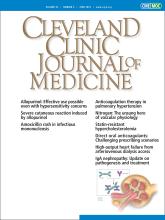
In this issue of the Journal, Bocchi et al1 remind us of the propensity of allopurinol to cause severe, life-threatening systemic hypersensitivity reactions and erythroderma. These reactions are fortunately quite rare (a few per thousand patient years), but allopurinol is one of the drugs most commonly associated with Stevens-Johnson syndrome and toxic epidermal necrolysis. Mortality associated with the latter likely remains greater than 20%.
Fear of this adverse effect led to the generation of dosing guidelines in 1984 with the hope of minimizing the occurrence of allopurinol hypersensitivity syndrome (AHS) and severe dermatitis.2 Those guidelines were based on pharmacokinetic data and have never been clinically validated as necessary or effective. Furthermore, if adhered to, likely fewer than a third of patients will have their serum urate level reduced to the minimal target level (< 6 mg/dL) needed to successfully treat their gout. This is especially true when applying the guidelines in patients with chronic kidney disease (CKD), an extremely frequent comorbidity in patients with gout.3 Valid concern over the possibility of this severe reaction, and a superficial understanding of the dosing guidelines based on creatinine clearance,2 have contributed to widespread undertreatment, including allopurinol underdosing, of patients with gout. Additionally, there remains an unsupported fear of renal toxicity from “treat-to-target” allopurinol dosing in patients with CKD.
Hande at al2 astutely recognized that a large fraction of patients experiencing AHS had “renal insufficiency.” They meticulously described the pharmacokinetics of allopurinol and its active metabolite oxypurinol, which is renally cleared in parallel with creatinine. They calculated the dose of allopurinol needed at different rates of creatinine clearance to achieve an oxypurinol serum level equal to what would be obtained with a 300-mg dose of allopurinol in a patient with normal kidney function. The assumption was that allopurinol doses higher than 300 mg, especially in the setting of “renal insufficiency,” would result in toxic levels of oxypurinol.
A corollary of this dosing based on estimated glomerular filtration rate (eGFR) was that 400 mg became the maximal dose, even in patients with a normal eGFR. This reasoning works well with predicting side effects from medications like the aminoglycosides, but does not necessarily fit with toxicity that is immunologically based, which is the case for allopurinol. Additionally, an allopurinol dose of 300 mg is too low for many patients with gout; the US Food and Drug Administration dosing is limited to 800 mg (doses > 800 mg have not been sufficiently studied). Forty years later, it still has not been demonstrated that adherence to Hande et al’s guidelines2 for maintenance dosing of allopurinol will reduce the frequency of AHS or provide adequate urate-lowering therapy for patients with gout and CKD.
CKD remains a recognized risk factor for the development of AHS, but the risk does not seem to be based on direct tissue damage from a toxic level of oxypurinol. Other risk factors include the presence of the human leukocyte antigen (HLA)-B*58:01 gene variant and, curiously, the initiating but not the maintenance dose of allopurinol. Oxypurinol can activate CD8+ T cells via direct binding to HLA-B*58:01 molecules, in a concentration-dependent manner,4 although the minority of patients with this allele will experience a toxic reaction. The explanation for why the combination of CKD and the presence of this HLA class I molecule increases the likelihood of AHS remains elusive. Nonetheless, the American College of Rheumatology recommends HLA testing in patients belonging to groups with a high prevalence of the HLA-B*58:01 allele.5 This includes persons of Han Chinese, Korean (those with CKD), and Thai descent, and African Americans (with an allele prevalence of about 4%). Implementation of a screening program in Taiwan with avoidance of allopurinol in patients positive for the allele markedly reduced the occurrence of AHS.6
The shadow of the Hande et al guidelines2 still hangs over clinical decision-making. There remain discrepant guidelines on how to manage dosing of allopurinol in the setting of CKD. Two large database observational studies7,8 and some smaller studies,9 though their findings are biologically difficult to explain, have contributed significantly to our pragmatic approach to treating the patient with gout and CKD. Keller et al8 used a US Medicaid database of more than 400,000 people and confirmed the increased risk of AHS in those populations with the HLA-B*58:01 haplotype or CKD, but, importantly, also noted that patients who received an initial (not maintenance) allopurinol dose higher than 100 mg (based on prescription data) were at greater risk of developing allopurinol reactions.
Using a similar approach, Bathini et al7 studied 47,315 patients 66 years or older with CKD and eGFR less than 60 mL/min/1.73 m2. They evaluated the effect of the initial allopurinol prescription strength (> 100 mg vs ≤ 100 mg) on subsequent hospitalization for a severe skin reaction within 180 days after starting the medication (the time period in which almost all allopurinol hypersensitivity reactions occur). They found a significant difference in the hospitalization rate: 0.4% vs 0.18% in high- vs low-dosed patients. Importantly, they also noted that, after 180 days, there was no increase in the occurrence of AHS in patients with CKD whose allopurinol dose was titrated upward vs those who stayed at a low dose. This is important because 100 mg is not likely to provide a clinically relevant lowering of serum urate. That allopurinol, after starting at a low dose, can be titrated upward has been supported by Stamp et al9,10 from New Zealand and endorsed by the American College of Rheumatology.5
My own practice, which is not directly supported by any rigorously derived evidence, is to start all patients on an allopurinol dose of 50 mg, regardless of their renal function. I do this because it may reduce the likelihood of severe allopurinol adverse reactions, especially in the setting of CKD. For patients in whom after discussion we have decided that there is no urgency in resolving tophaceous deposits, and thus do not plan on starting enzyme replacement therapy with a uricase, there is no urgency to rapidly reduce the serum urate to my desired target level (I usually aim for 5.5–6 mg/dL, lower in the presence of palpable tophi or demonstrated erosive bone disease). By starting patients at a low dose and slowly titrating upward to ultimately attain the target serum urate, I believe we can reduce the likelihood of “mobilization flares” of their gout.11 I also try to use anti-inflammatory prophylaxis against flares in all patients, and I try to check the HLA-B*58:01 status of those at higher risk of having this haplotype before starting allopurinol.
I believe that allopurinol appropriately currently remains the first-line urate-lowering therapy for most patients with gout. It is easily titratable to a therapeutic dose and is affordable. The presence of CKD should not present an insurmountable obstacle to using the drug long term, particularly if there are any concerns with the use of febuxostat or probenecid, which, at present, are the only real alternatives in the United States. Fortunately, several new potential urate-lowering drugs are in late stages of clinical development.
- Copyright © 2025 The Cleveland Clinic Foundation. All Rights Reserved.






